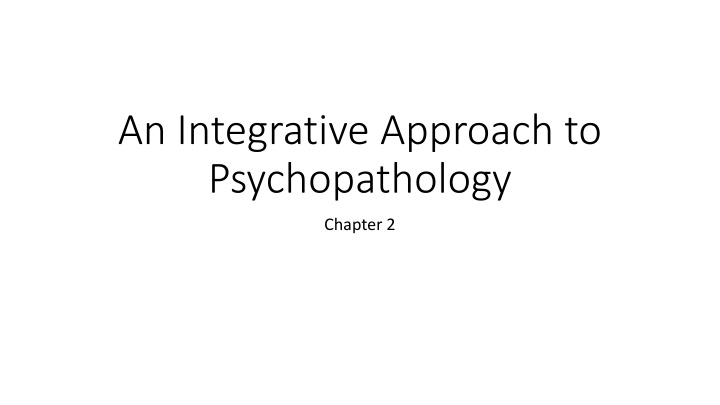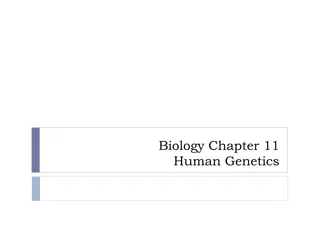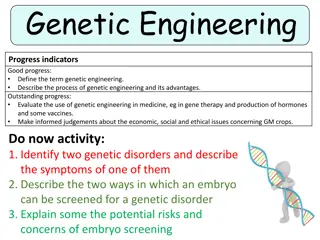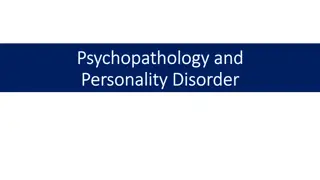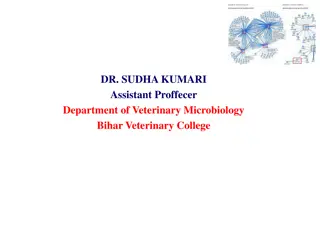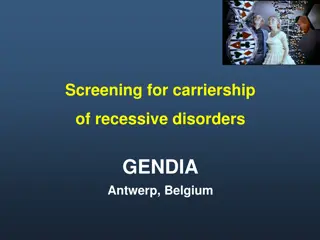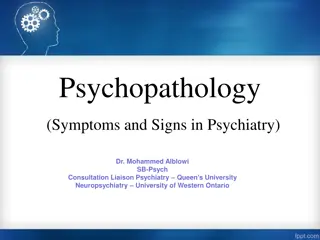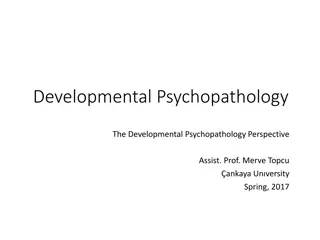Multidimensional Models and Genetic Contributions to Psychopathology
This chapter explores the multidimensional models of psychopathology, including biological, behavioral, emotional, social, and developmental influences. It delves into genetic contributions, the interaction of genes and environment, and neuroscience explanations involving the central and peripheral nervous systems. Understanding the role of genes, neurotransmitters, and the nervous system provides insight into the complexity of psychological disorders.
Download Presentation

Please find below an Image/Link to download the presentation.
The content on the website is provided AS IS for your information and personal use only. It may not be sold, licensed, or shared on other websites without obtaining consent from the author.If you encounter any issues during the download, it is possible that the publisher has removed the file from their server.
You are allowed to download the files provided on this website for personal or commercial use, subject to the condition that they are used lawfully. All files are the property of their respective owners.
The content on the website is provided AS IS for your information and personal use only. It may not be sold, licensed, or shared on other websites without obtaining consent from the author.
E N D
Presentation Transcript
An Integrative Approach to Psychopathology Chapter 2
Multidimensional Models Biological Influences Behavioral Influences Emotional Influences Social Influences Developmental Influences
Genetic Contributions Phenotype (observable) vs. Genotype (genetic makeup) Nature of Genes Deoxyribonucleic acid (DNA) The double helix 23 pairs of chromosomes Dominant vs. recessive genes Development and behavior is often polygenetic Genetic Contribution to Psychopathology Less than 50% Epigenetics- the environment influences gene development
Interaction of Genes and Environment The Diathesis-Stress Model Examples: Blood-injury-injection phobia, alcoholism Reciprocal Gene-Environment Model Examples: Depression, impulsivity Non-Genomic Inheritance of Behavior Genes are not the whole story
Neuroscience contributions The Central Nervous System (CNS) Brain and spinal cord The Peripheral Nervous System (PNS) Somatic and autonomic branches
CNS The Neuron Soma Cell body Dendrites Branches that receive messages from other neurons Axon Trunk of neuron that sends messages to other neurons Axon terminals Buds at end of axon from which chemical messages are sent Synaptic cleft Small gaps that separate neurons Neurons Function Electrically, but Communicate Chemically Neurotransmitters are the chemical messengers
Neurotransmitters Norepinephrine (or noradrenaline) Serotonin Dopamine Gamma Aminobutyric Acid (GABA) Focus of many medications chemical imbalance hypothesis
Peripheral Nervous and Endocrine Somatic Branch of PNS: Controls voluntary muscles and movement Autonomic Branch of the PNS Sympathetic and parasympathetic branches Regulates cardiovascular system & body temperature Also regulates the endocrine system and aids in digestion The Endocrine System: Hormones The Hypothalamic-Pituitary-Adrenalcortical Axis (HYPAC axis) Integration of endocrine and nervous system function
Function of Neurotransmitters Functions of Neurotransmitters Agonists, antagonists, and inverse agonists Most drugs are either agnostic or antagonistic Main Types of Neurotransmitters Serotonin (5HT) Gamma aminobutyric acid (GABA) Norepinephrine Dopamine
Implications Relations Between Brain and Abnormal Behavior Example: Obsessive compulsive disorder (OCD) https://www.youtube.com/watch?v=wvodgCQ5F-0 Experience Can Change Brain Structure and Function Therapy Can Change Brain Structure and Function Medications and psychotherapy
D-cycloserine Antibiotic used in OCD treatment No side-effects Speed up therapeutic response- get more from ERP sessions Doesn t help OCD just taking it Reduce early frustration and drop out Works on neurotransmitters in the amygdala associated with learning and memory: facilitate learning/fear extinction
Role of Emotions Behavior-Cognitions-Affect Emotions influenced by: Thoughts Behaviors Physiology
Cultural, Social, Interpersonal Factors Cultural Factors Influence the form and expression of normal and abnormal behavior Gender Effects Exerts a strong and puzzling effect on psychopathology Social Relationships Frequency and quality related to mortality, disease, and psychopathology Interpersonal Psychotherapy Stigma of Psychopathology is Culturally, Socially, and Interpersonally Situated
Lifespan Life-Span Developmental Perspective Addresses developmental changes Such changes influence and constrain what is normal and abnormal The Principle of Equifinality Concept in developmental psychopathology Several paths to a given outcome Paths may operate differentially at different developmental stages
Multidimensional perspective Multiple Causation Is the rule, not the exception in explaining normal and abnormal behavior Take a Broad, Comprehensive, Systemic Perspective Addressing biological, psychological, social, cultural, and developmental factors Useful in Understanding the Causes of Psychopathology and its Alleviation
